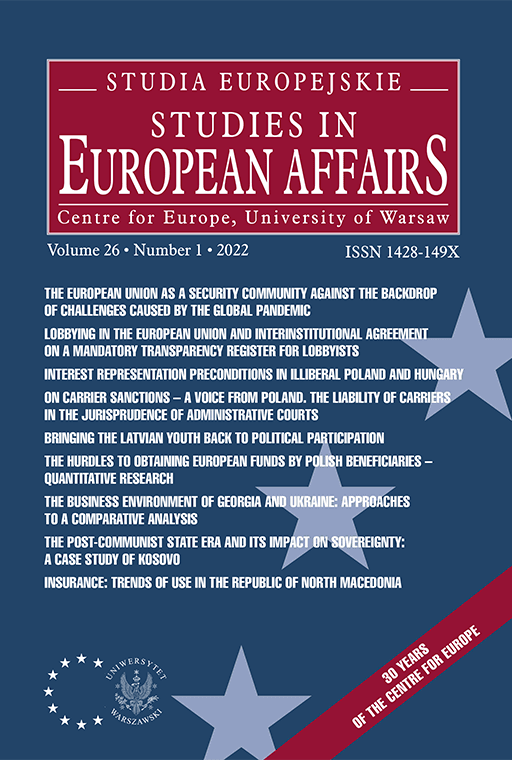
ISSUE: 1/2022
- Volume 26
- Number 1
- 2022
Subscribe NEWSLETTER
Studia Europejskie –
Studies in European Affairs
ISSN: 1428-149X
e-ISSN: 2719-3780
License
Articles published in the journal are under a Creative Commons Attribution – Non Commercial – No Derivatives 4.0 International License
The Hurdles to Obtaining European Funds by Polish Beneficiaries – Quantitative Research
Abstract
The main objective for writing this article is to present the barriers to accessing EU funds at the stage of preparing an application for funding, as well as the barriers to executing project activities. The research objective, question, and problem as well as the statistical description of the research group and the measurement instruments have been highlighted in the article. The author attempts to answer the following questions: what are the main barriers/hurdles encountered by Polish benefi ciaries of EU funds allocated under national and regional operational programmes; which of the identified barriers to accessing EU funds is perceived as the most hindering in the process of executing EU projects; and how is the impact of EU funds on regional development assessed from the perspective of those people executing projects and taking part in projects financed with EU funds? The following barriers can be enumerated as the most signifi cant: the withholding of subsequent funding tranches while maintaining the obligation to pursue project execution, the highly bureaucratic application process for a subsidy, the bureaucratic system of post-project accounting, and the long deadlines for transferring subsequent tranches of funding. An analysis of the findings confirms that the beneficiaries of EU funds primarily fear losing fi nancial liquidity. Receiving a subsidy in the form of a refinancing of the incurred costs requires, on the one hand, effi cient project management, and, on the other, a well-functioning institutional system that should support project recipients in their investment endeavours.
References
Antosiewicz, M. et al. (2017) Ewaluacja ex-post wpływu funduszy unijnych w ramach perspektywy finansowej 2007–2013 na podstawowe wskaźniki
innowacyjności i działalności R+R, Warszawa: Imapp Sp. z o.o.
Bartkiewicz, P. and Dębowski, H. (2010) Ocena wpływu polityki spójności na wzrost konkurencyjności i innowacyjności polskich przedsiębiorstw i gospodarki. Warsaw: Instytut Badań Strukturalnych, Reytech Sp. z o.o.
Bostan, I. et al. (2019) “The Three-dimensional Impact of the Absorption Effects of European Funds on the Competitiveness of the SMEs from the Danube Delta”, Industrial Crops & Product. Vol. 132. DOI: https://doi.org/10.1016/j.indcrop.2019.02.053.
Brzeziński, J. (2005) Metodologia badań psychologicznych, Warszawa: PWN.
Chojecki, J. et al. (2017) Metaanaliza wyników badań ewaluacyjnych dotyczących oceny wsparcia z EFS – Raport cząstkowy I. Warszawa: Ministerstwo Rozwoju.
Churchill, Jr. and Peter, J.P. (1984) “Research Design Effects on the Reliability of Rating Scales: A Meta-analysis”, Journal of Marketing Research. Vol. 21(4). DOI: https://doi.org/10.2307/3151463.
Dubel, P. (2020) Zarządzanie funduszami strukturalnymi Unii Europejskiej a polityka rozwoju regionalnego. Projekty i ich realizacja. Warszawa: PWE.
Ewaluacja. Fundusze Europejskie (2017) The impact of Cohesion policy 2007–2013 in Poland. Available at: https://www.ewaluacja.gov.pl/strony/badania-i-analizy/wyniki-badan-ewaluacyjnych/badaniaewaluacyjne/the-impact-of-cohesion-policy-2007-2013-in-poland/ (Access 1.02.2022).
Portal Funduszy Europejskich (2022) Analizy, Raporty, Podsumowania. Available at: https://www.funduszeeuropejskie.gov.pl/strony/o-funduszach/raporty (Access 1.02.2022).
Eurostat (2022) All publication. Available at: https://ec.europa.eu/eurostat/publications/all-publications (Access 1.02.2022).
KE (2014) Inwestycje na rzecz wzrostu gospodarczego i zatrudnienia. Promowanie rozwoju i dobrego rządzenia w regionach UE i miastach. Szósty
raport na temat spójności gospodarczej, społecznej i terytorialnej, Dijkstra L. Bruksela: KE, Dyrekcja Generalna ds. Polityki Regionalnej i Miejskiej.
Kwieciński, J. and Kalamon, B. (2014) Stan wykorzystania funduszy europejskich VIII raport. Warszawa: Business Centre Club.
Trzciński, R. (2018) Ustalenie wartości wybranych wskaźników ekonomicznych dla odbiorców pomocy, udzielanej za pośrednictwem PARP w ramach POIR i POPW, oraz dla dobranych grup kontrolnych. Warszawa: Centrum Badań i Edukacji Statystycznej GUS.
Tö dtling-Schö nhofer, H. et al. (2012) Bariery dla podmiotów ubiegających się o środki z funduszy strukturalnych. Bruksela: European Parliament’s
Committee on Regional Development.
Ward P., Clark, T. and Zabriskie, R. (2014) “Paper/Pencil Versus Online Data Collection An Exploratory Study”, Journal of Leisure Research. Vol. 46(1), DOI: https://doi.org/10.1080/00222216.2014.11950314.
Wieczorkowska, G. and Wierzbiński, J. (2011) Statystyka od teorii do praktyki. Warszawa: Scholar.
Zub, M., et al. (2015) Badanie skuteczności wsparcia realizowanego w ramach komponentu regionalnego PO KL 2007–2013. Warszawa: Policy & Action Group Uniconsult Sp. z o.o.
DOI: 10.33067/SE.1.2022.6
Language: English
Pages: 101-117
How to Cite:
Harvard
Dubel, P. (2022) "The Hurdles to Obtaining European Funds by Polish Beneficiaries – Quantitative Research". Studia Europejskie – Studies in European Affairs, 1/2022, pp. 101-117. DOI: 10.33067/SE.1.2022.6